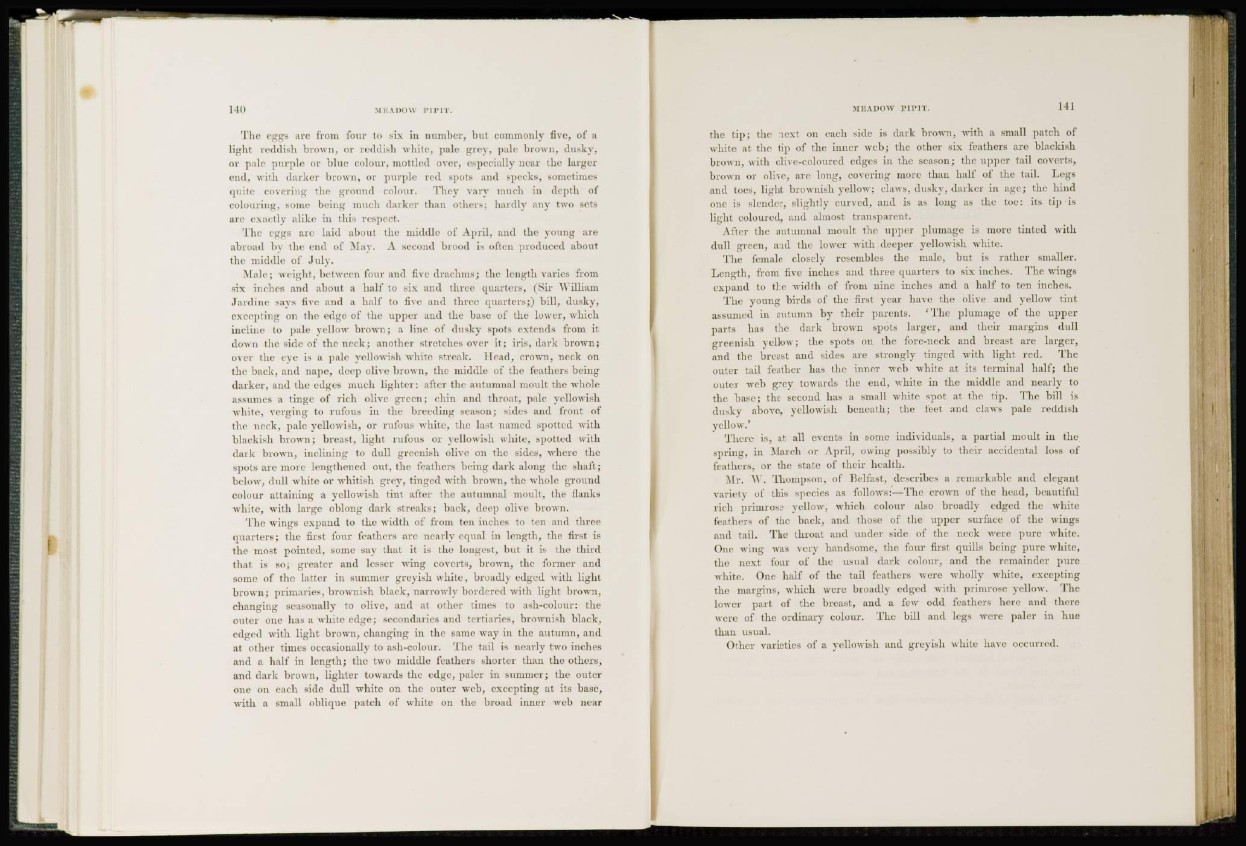
The eggs are from four to six in number, but commonly five, of a
light reddish brown, or reddish white, pale grey, pale brown, dusky,
or pale purple or blue colour, mottled over, especially near the larger
end, with darker brown, or purple red spots and specks, sometimes
quite covering the ground colour. They vary much in depth of
colouring, .some being much darker than others; hardly any two sets
are exactly alike in this respect.
The eggs are laid about the middle of April, and the young are
abroad by the end of May. A second brood is often produced about
the middle of July.
Male; weight, between four and five drachms; the length varies from
six inches and about a half to six and three quarters, (Sir W illiam
Jardine says five and a half to five and three quarters;) bill, dusky,
excepting on the edge of the upper and the base of the lower, which
incline to pale yellow brown; a line of dusky spots extends from it
down the side of the neck; another stretches over it; iris, dark brown;
over the eve is a pale yellowish white streak. Head, crown, neck on
the back, and nape, deep olive brown, the middle of the feathers being
darker, and the edges much lighter: after the autumnal moult the whole
assumes a tinge of rich olive green; chin and throat, pale yellowish
white, verging to rufous in the breeding season; sides and front of
the neck, pale yellowish, or rufous white, the last named spotted with
blackish brown; breast, light rufous or yellowish white, spotted with
dark brown, inclining to dull greenish olive on the sides, where the
spots are more lengthened out, the feathers being dark along the shaft;
below, dull white or whitish grey, tinged with brown, the whole ground
colour attaining a yellowish tint after the autumnal moult, the flanks
white, with large oblong dark streaks; back, deep olive brown.
The wings expand to the width of from ten inches to ten and three1
quarters; the first four feathers are nearly equal in length, the first is
the most pointed, some say that it is the longest, but it is the third
that is so; greater and lesser wing coverts, brown, the former and
some of the latter in summer greyish white, broadly edged with light
brown; primaries, brownish black, narrowly bordered with light brown,
changing seasonally to olive, and at other times to ash-colour: the
outer one has a white edge; secondaries and tertiaries, brownish black,
edged with light brown, changing in the same way in the autumn, and
at other times occasionally to ash-colour. The tail is nearly two inches
and a half in length; the two middle feathers shorter than the others,
and dark brown, lighter towards the edge, paler in summer; the outer
one on each side dull white on the outer web, excepting at its base,
with a small oblique patch of white on the broad inner web near
the tip; the next on each side is dark brown, with a small patch of
white at the tip of the inner web; the other six feathers are blackish
brown, with olive-coloured edges in the season; the upper tail coverts,
brown or olive, are long, covering more than half of the tail. Legs
and toes, light brownish yellow; claws, dusky, darker in age; the hind
one is slender, slightly curved, and is as long as the toe: its tip is
light coloured, and almost transparent.
After the autumnal moult the upper plumage is more tinted with
chdl green, and the lower with deeper yellowish white.
The female closely resembles the male, but is rather smaller.
Length, from five inches and three quarters to six inches. 'The wings
expand to the width of from nine inches and a half to ten inches.
The young birds of the first year have the olive and yellow tint
assumed in autumn by their parents. 'The plumage of the upper
parts has the- dark brown spots larger, and their margins dull
greenish yellow; the spots on the fore-neck and breast are larger,
and the breast and sides are strongly tinged with light red. The
outer tail feather has the inner web white at its terminal half; the
outer web grev towards the end, white in the middle and nearly to
the base; the second has a small white spot at the tip. The bill is
dusky above, yellowish beneath; the feet and claws pale reddish
yellow.'
'There is, at all events in some individuals, a partial moult in the
spring, in March or April, owing possibly to their accidental loss of
feathers, or the state of their health.
Mr. W. Thompson, of Belfast, describes a remarkable and elegant
variety of this species as follows:—The crown of the head, beautiful
rich primrose yellow, which colour also broadly edged the white
feathers of the back, and those of the upper surface of the wings
and tail. The throat and under side of the neck were pure white.
One wing was very handsome, the four first quills being pure white,
the next four of the usual dark colour, and the remainder pure
white. One half of the tail feathers were wholly white, excepting
the margins, which were broadly edged with primrose yellow. The
lower part of the breast, and a few odd feathers here and there
were of the ordinary colour. The bill and legs were paler in hue
than usual.
Other varieties of a yellowish and greyish white have occurred.